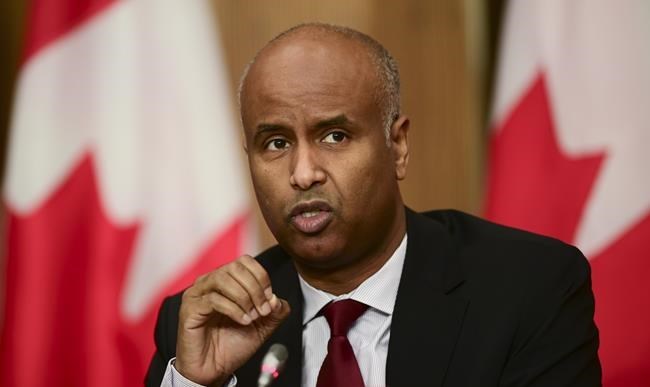OTTAWA — Changes to the federal plan to finance experimental ways to deliver social services should more easily and quickly bring in needed private-sector backers for the strategy to work, says the minister on the file.
Social Development Minister Ahmed Hussen said the changes respond to the concerns he heard from social-purpose organizations over the last year as their revenues dropped and demand for their services rose.
Last month's federal budget outlined a pledge to boost near-term spending for groups to partner with a private investor and test ways of delivering services like skills training.
The budget would also redo the parameters of the program to have the federal treasury take on a little more financial risk to lure the private capital needed.
Hussen said in an interview Monday that the risk is necessary if the government wants to lure private dollars and stretch public funds first pledged three years ago.
The Liberals set aside $755 million in a social-finance fund in 2018, banking that it would bring private money, and some private-sector discipline, into social services governments typically either provide themselves or pay for directly — sometimes ineffectively.
Instead of directly funding positions at a company, a group would have a private backer front the money, and public coffers would only pay any profit if the program works, saving the government money up front and over time.
"We know that every crisis is followed by a recession, and every recession is followed by austerity measures. So we're going to have scaled back social safety nets," said Mojdeh Cox, executive director of Pillar Nonprofit Network, which helps social enterprises scale and grow.
"We can actually offset some of the impact of that as a community-at-large by by talking about recovery in tangible ways."
This year's budget moved up some of the planned spending so that the fund would dole out $220 million this year and next, instead of the $170 million originally envisioned, as seed money to local and regional funds that will encourage these kinds of financing arrangements.
The Liberals are also hoping to boost rebounding investor appetite by loosening rules to allow for some of the funding to not be repaid, and attract by Hussen's estimates $2 of private money for every $1 of public dollars.
"If we want to support new ways of doing things and expansion and creating and attracting more private-sector capital, then the government has to be seen to be at least willing and open to a little bit more risk," Hussen said.
Money from the fund likely won't move to smaller or community funds until the end of the year, and Hussen suggested some of it would go to groups that traditionally have a hard time accessing seed money, such as Black women, Indigenous people, and people of colour.
"The capital the government is deploying can be catalytic, in particular to groups that tend to be under-represented at the leadership level of social finance," said Narinder Dhami, managing partner at Toronto-based Marigold Capital, which invests in companies helping reduce social and economic barriers for marginalized groups.
The budget also adds a further $50 million to help groups build capacity and take part in the growing field. The first round of the readiness program helped 680 groups, Hussen said, more than the 500 originally envisioned.
Adam Spence, chief executive of Social Venture Connexion, which works with and connects investors, social finance funds and service groups, said the various measures are all welcome, and now the sector is keen to see the rollout of the social finance fund happen as rapidly as possible.
"There are tremendous and in many cases growing needs, whether it's from housing to food systems, to racialized communities, that have been incredibly hard hit by the pandemic," he said.
"These folks are ready for that capital to flow."
This report by The Canadian Press was first published May 10, 2021.
Jordan Press, The Canadian Press

